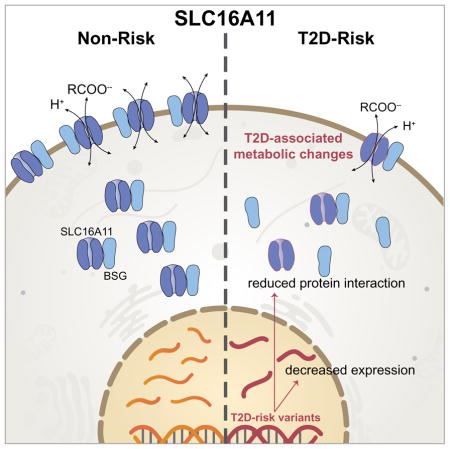SLC16A11 is also known as Monocarboxylate transporter 11, MCT 11, Solute carrier family 16 member 11. It is a member of the SLC16 (or monocarboxylate transporter, MCT) family, a group of 14 solute carriers that is defined by two highly conserved sequences. Three-dimensional homology modeling of SLC16A11 based on the solved structure of the bacterial glycerol 3 phosphate transporter (GlPT) suggests that SLC16A11 belongs to category I and it might transport monocarboxylates via a H⁺-coupled mechanism.
| Basic Information of SLC16A11 | |
| Protein Name | Monocarboxylate transporter 11 |
| Gene Name | SLC16A11 |
| Aliases | MCT 11, Solute carrier family 16 member 11 |
| Organism | Homo sapiens (Human) |
| UniProt ID | Q8NCK7 |
| Transmembrane Times | 12 |
| Length (aa) | 471 |
| Sequence | MPAPQRKHRRGGFSHRCFPTPQTAMTPQPAGPPDGGWGWVVAAAAFAINGLSYGLLRSLGLAFPDLAEHFDRSAQDTAWISALALAVQQAASPVGSALSTRWGARPVVMVGGVLASLGFVFSAFASDLLHLYLGLGLLAGFGWALVFAPALGTLSRYFSRRRVLAVGLALTGNGASSLLLAPALQLLLDTFGWRGALLLLGAITLHLTPCGALLLPLVLPGDPPAPPRSPLAALGLSLFTRRAFSIFALGTALVGGGYFVPYVHLAPHALDRGLGGYGAALVVAVAAMGDAGARLVCGWLADQGWVPLPRLLAVFGALTGLGLWVVGLVPVVGGEESWGGPLLAAAVAYGLSAGSYAPLVFGVLPGLVGVGGVVQATGLVMMLMSLGGLLGPPLSGFLRDETGDFTASFLLSGSLILSGSFIYIGLPRALPSCGPASPPATPPPETGELLPAPQAVLLSPGGPGSTLDTTC |
SLC16A11 is expressed in relatively few tissues, with the highest levels detected in thyroid, liver, and salivary gland, however, the role of SLC16A11 in these tissues has not been characterized very clearly yet. The structural analyses according to the Three-dimensional homology modeling of SLC16A11 based on the solved structure of the bacterial glycerol-3-phosphate transporter (GlPT) suggest that SLC16A11 belongs to category I, and it might transport monocarboxylates via an H⁺-coupled mechanism. Some (presumably, non-coding regulatory) variants on the Type 2 Diabetes risk haplotype lead to decreased gene expression of SLC16A11 in liver, while coding variants affect the interaction of the SLC16A11 protein with basigin leading to reduced levels of the transporter at the cell surface. More importantly, disruption of SLC16A11 in primary human hepatocytes leads to T2D-relevant changes in fatty acid and lipid metabolism. Reduced SLC16A11 that functions in liver might be a causal factor for Type 2 Diabetes, suggesting that SLC16A11 might be a novel therapeutic target.
 Fig.1 Proposed signaling pathway of SLC16A11 in Type 2 Diabetes. (Rusu, 2017)
Fig.1 Proposed signaling pathway of SLC16A11 in Type 2 Diabetes. (Rusu, 2017)
The results of this article demonstrate that SLC16A11 is a proton-coupled monocarboxylate transporter, and that genetic perturbation of SLC16A11 induces changes in fatty acid and lipid metabolism that are associated with increased Type 2 Diabetes risk. The findings suggest that increasing SLC16A11 function could be therapeutically beneficial for Type 2 Diabetes.
Authors in this group apply genetic studies in multiple human populations to identify SLC16A11 as a novel candidate gene for Type 2 Diabetes with a possible role in triacylglycerol metabolism.
This article indicates that SLC16A1 /rs13342232 might be involved in the risk of pediatric-onset Type 2 Diabetes in Mexican families because the G allele of SLC16A1 /rs13342232 was associated with Type 2 Diabetes in adults.
The authors in this article analyze SLC16A11 in 12,811 North American Indians and found that the diabetes risk haplotype, tagged by the rs75493593 A allele, was nominally associated with type 2 diabetes.
This article suggests that ABCA1 and SLC16A11 are related mainly to impaired metabolic traits and consequently involved in type 2 diabetes susceptibility.
To obtain the soluble and functional target protein, the versatile Magic™ membrane protein production platform in Creative Biolabs enables many flexible options, from which you can always find a better match for your particular project. Aided by our versatile Magic™ anti-membrane protein antibody discovery platform, we also provide customized anti-SLC16A11 antibody development services.
Creative Biolabs is the leading custom service provider that has extensive experience in the field of membrane protein. Our service portfolio has won a good reputation among our worldwide customers for successfully accomplishing numerous challenging projects including generation of many functional membrane proteins. Please feel free to contact us for more information.
Reference
All listed services and products are For Research Use Only. Do Not use in any diagnostic or therapeutic applications.